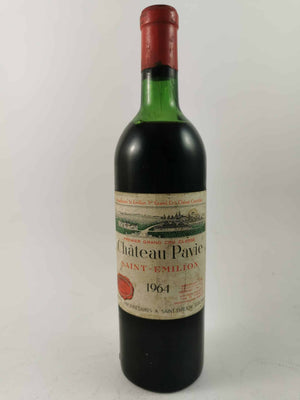- Our Shop

$998.99
The palate is powerful and complex. A wine of great finesse and an impressive length in the mouth.
Order from the Largest & Most Trusted Premium Spirits Marketplace!
Featured in
NOTICE: Many other small liquor store sites may end up cancelling your order due to the high demand, unavailability or inaccurate inventory counts. We have partnerships consisting of a large network of licensed retailers from within the United States, Europe and across the world ensuring orders are fulfilled.
Producer: Château Pavie
Vintage: 1964
Size: 750ml
ABV: 13%
Varietal: Bordeaux Blend Red
Country/Region: France, Saint-Emilion
The palate is powerful and complex. A wine of great finesse and an impressive length in the mouth.
Château Pavie is a critically acclaimed – if sometimes controversial – wine estate in the Saint-Émilion appellation of northeastern Bordeaux, on the right bank of the Dordogne river. Originally named a Premier Grand Cru Classé (B) in the 1955 classification of Saint-Émilion wines, it was promoted to Premier Grand Cru Classé (A) status in the 2012 iteration. It is known for its Merlot-dominant grand vin. The 37-hectare (91-acre) Pavie estate lies just east of Saint-Émilion town, sitting on the southern edge of the Saint-Émilion plateau. The estate vineyards have a coveted position, enjoying both the limestone bedrock of the plateau and the south-facing slope that both drains excess water and gets excellent exposure to the sun. The site is believed to have been planted with vines since Roman times and, over the centuries, has seen many owners and changes in its boundaries. The current property coverage was heavily influenced by the land purchases (and divisions) of Ferdinand Bouffard in the late 19th Century. Bouffard bought a number of vineyards and châteaux, laying the foundations not just for Pavie but several of its neighboring estates, although he continued to manage them as separate entities. By the early 20th Century, Château Pavie had been divided into three, with Pavie Macquin and Pavie Decesse established from land covered by the original Pavie estate. Pavie remains the largest of the three and is one of the larger estates in Saint-Émilion. Château Pavie was named a Premier Grand Cru Classé (B) in the inaugural 1955 classification of Saint-Émilion and for decades as a well-regarded, if sometimes underperforming, estate. French supermarket moghul Gérard Perse bought Pavie in 1998 (having previously bought Château Monbousquet in 1993 and Pavie Decesse in 1997) and, as with his previous vineyard purchases, Perse implemented significant upgrades to the vineyards and winery. Many of the vines were replanted, and Michel Rolland was hired as consultant winemaker. Subsequent Pavie vintages have been markedly different and have created some controversy. The new wines are known for their riper, fuller and more extracted expressions with high alcohol content. Perse’s wines were generally well received by American critic Robert Parker, but not so favorably by others. The 2003 release of the wine was notable in that it polarised two of the biggest names in wine at the time, receiving a poor review from UK wine doyenne Jancis Robinson MW while being lauded by Parker.
Only logged in customers who have purchased this product may leave a review.
Bourbon Bridges Ltd ©2024 Privacy Policy

THE ALCOHOL PRODUCTS ON THIS WEBSITE ARE INTENDED FOR ADULTS ONLY.
By entering this website, you certify that you are of legal drinking age in the location in which you reside (age 21+ in the United States).
Reviews
There are no reviews yet.